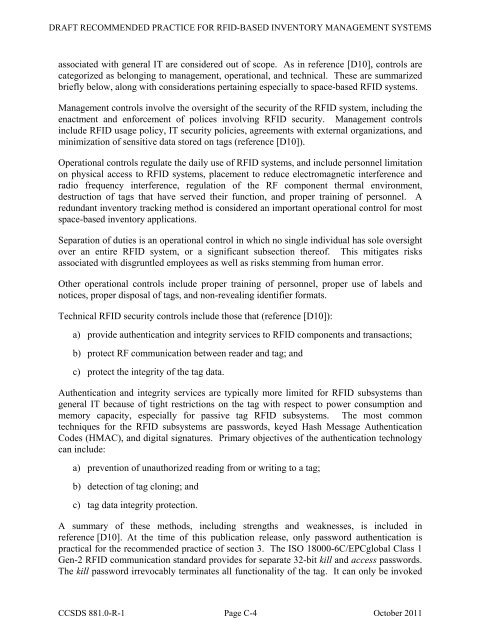CCSDS 881.0-R-1, Spacecraft Onboard Interface ServicesâRFID ...
CCSDS 881.0-R-1, Spacecraft Onboard Interface ServicesâRFID ...
CCSDS 881.0-R-1, Spacecraft Onboard Interface ServicesâRFID ...
Create successful ePaper yourself
Turn your PDF publications into a flip-book with our unique Google optimized e-Paper software.
DRAFT RECOMMENDED PRACTICE FOR RFID-BASED INVENTORY MANAGEMENT SYSTEMSassociated with general IT are considered out of scope. As in reference [D10], controls arecategorized as belonging to management, operational, and technical. These are summarizedbriefly below, along with considerations pertaining especially to space-based RFID systems.Management controls involve the oversight of the security of the RFID system, including theenactment and enforcement of polices involving RFID security. Management controlsinclude RFID usage policy, IT security policies, agreements with external organizations, andminimization of sensitive data stored on tags (reference [D10]).Operational controls regulate the daily use of RFID systems, and include personnel limitationon physical access to RFID systems, placement to reduce electromagnetic interference andradio frequency interference, regulation of the RF component thermal environment,destruction of tags that have served their function, and proper training of personnel. Aredundant inventory tracking method is considered an important operational control for mostspace-based inventory applications.Separation of duties is an operational control in which no single individual has sole oversightover an entire RFID system, or a significant subsection thereof. This mitigates risksassociated with disgruntled employees as well as risks stemming from human error.Other operational controls include proper training of personnel, proper use of labels andnotices, proper disposal of tags, and non-revealing identifier formats.Technical RFID security controls include those that (reference [D10]):a) provide authentication and integrity services to RFID components and transactions;b) protect RF communication between reader and tag; andc) protect the integrity of the tag data.Authentication and integrity services are typically more limited for RFID subsystems thangeneral IT because of tight restrictions on the tag with respect to power consumption andmemory capacity, especially for passive tag RFID subsystems. The most commontechniques for the RFID subsystems are passwords, keyed Hash Message AuthenticationCodes (HMAC), and digital signatures. Primary objectives of the authentication technologycan include:a) prevention of unauthorized reading from or writing to a tag;b) detection of tag cloning; andc) tag data integrity protection.A summary of these methods, including strengths and weaknesses, is included inreference [D10]. At the time of this publication release, only password authentication ispractical for the recommended practice of section 3. The ISO 18000-6C/EPCglobal Class 1Gen-2 RFID communication standard provides for separate 32-bit kill and access passwords.The kill password irrevocably terminates all functionality of the tag. It can only be invoked<strong>CCSDS</strong> <strong>881.0</strong>-R-1 Page C-4 October 2011

















